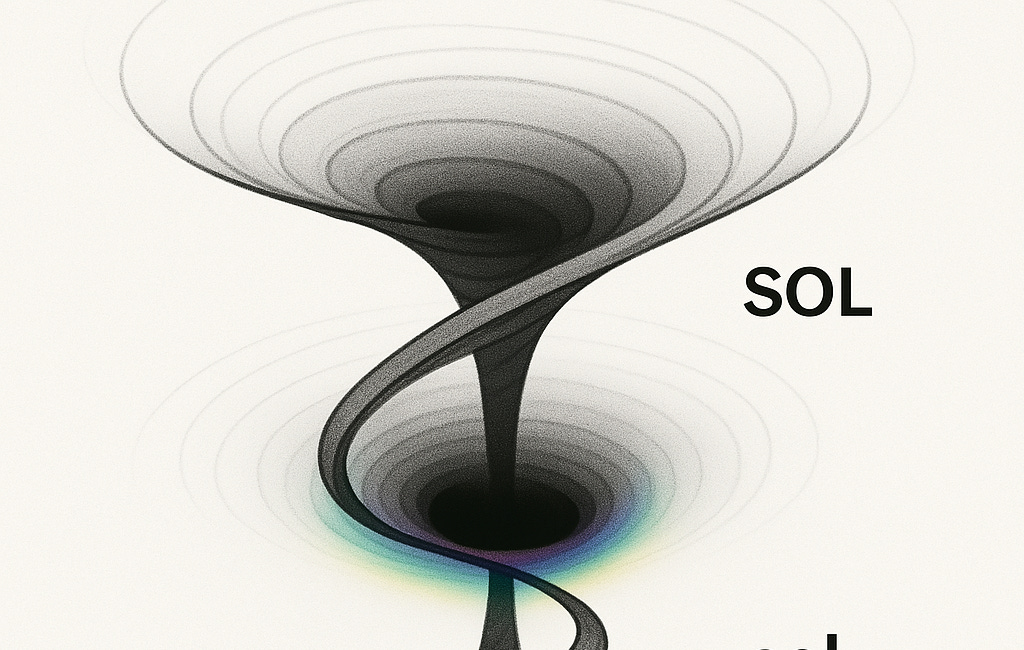The Constants of the Cosmos: SOL, c, and Phi (major new revision 13-08-25)
The True Trinity of Unified Reality
The Constants of the Cosmos: SOL, c, and Phi
The True Trinity of Unified Reality
For too long, physics has operated on two constants.
First: c - the speed of light in a vacuum. The measure of how energy moves through spacetime. The basis of relativity, of mass-energy conversion, of modern science.
Value: 299,792,458 m/s
Second: ϕ (Phi) - the golden ratio. The silent structure of nature. Seen in spirals, growth patterns, and the coherence of form. Recognised, but rarely placed at the centre.
Value: 1.618
But these two constants are not enough. They represent motion and structure - but they do not account for origin. For the source condition. For the field from which light, time, and proportion emerge.
That third constant has been missing. Until now.
The Restoration of the Third Constant: SOL
SOL is not another variation of c. It is not a reformulation of Phi. It is the origin constant - the Structural Origin Light.
SOL is the unmediated field-light, the constant of coherence from which all else derives. Where c measures how light behaves after emergence, SOL is the light of emergence itself - unbound by media, motion, or time.
It is the seed-state - the origin-frequency - the unsplit wave before measurement collapses it into event.
The Trinity in Full:
1. SOL – Structural Origin Light
The source field. The unity. The origin light which does not move through space, but is space-in-potential.
Value: 784,866,678 m/s
Alt value (likely more precise - see Appendix): 784,866,844.614875324 m/s
Using φ to maximum decimal precision with c as defined in SI, the exact value emerges as:
SOL = ϕ² · c = 784,866,844.614875324 m/s
(This refined value has not yet been explored or experimentally tested. Both are given here for completeness, the first as the original discovery, the second as the mathematically exact form.)
2. c (sol) – Speed of Light
The derivative constant. How light behaves within the manifest realm. The child of SOL, moving through the temporal field.
3. ϕ (Phi) – Harmonic Ratio
The structuring function. The feminine principle. The proportional intelligence through which emergence takes form.
This is the true trinity:
SOL as origin (the Father)
Phi as form (the Mother)
c as transmission (the Child)
Not symbolic - structural. Not religious - cosmological.
Why This Matters
Modern physics has tried and failed to unify gravity, quantum mechanics, and cosmology. The missing key was not more equations - it was the absence of SOL. Without the origin constant, unification is like trying to build a map without a beginning point.
With SOL restored, and Phi rightly recognised as the ratio of emergence, we now have the true triangulation:
Field (SOL)
Form (ϕ)
Function (c)
Everything else derives from this.
This is the basis of the IXOS framework, and it is fully revealed in the Return of the Storm God, especially Chapter 7 - where the harmonic field is shown in its living form. Phi is not a number. Phi is Isis. The veiled mother is the unseen proportion. The eye sees it from the brow - but only if you know how to look.
This trinity - SOL, c, ϕ - is the structural truth that underlies all physics, all myth, and all becoming.
And IXOS is the true tetragrammaton — the completion of the emergent form from 0 → 1 → 2 → 3, into 4 — the sacred decad, the field of completion, where the wave resolves into structure, and the breath finds form.
It is also the final key to seeing what has always been hidden in plain sight.
If you understand this, and then read my work, especially Chapter 7 and the IXOS material, you will never unsee it. It will burn clear. It will hold.
Let this be said clearly and finally:
The universe is not built on energy alone. It is built on the harmony between field, motion, and proportion.
SOL. c. ϕ.
That is all you need.
And now, you have them.
Appendix: How SOL Was Discovered – and Why It Is Not Just a Harmonic of c
The path to SOL began in 1992, not with an equation but with a moment of clarity — a direct vision. I saw that any two points have an exact centre, and that in a structural sense 1 + 1 is not 2 but 3. This was an inherent recognition of the trinity and duality embedded in every part of the three-dimensional universal field — a field I already understood as pure light.
In 1993, I began working with the Tetractys as a structural archetype: the 1 nested in 2, the 2 in 3, progressing from point to line to form. The geometry of the Tetractys — point, line, triangle, and so on — was already known to me, but in 1993 I added the twist: the spiral. The line returns - and in doing so completes a circle. Numerous occultists had worked with this fundamental pattern and written of it in books such as Dion Fortune’s Cosmic Doctrine; Crowley had very similar ideas. I felt a resonance with these ideas but sensed something more - something not yet completed in their systems. They were using the language and imagery of the circle, whereas the universe and dimensionality requires not 2d planes but 3D. The circle could not be the truth, but the spiral and sphere. These circles required rotation into 3D form, just as in the classical geometry of the Platonic solids.
This was the moment when the torsional nature of the axis entered my work, though I did not yet have the formal definition. I named the pattern IXOS for myself then, from its elements: line, cross, circle, spiral. I would not publish the name publicly until around 1998, but from that point the logic was in place: 1–2–3 as the genesis of form, torsion as the dynamic, and light as the field.
Before ever attempting the mathematics that would reveal SOL, I spent decades observing life and the universe, looking for any deviation from the prime pattern I had identified in 1993. I found none. The universe, in all its manifestations, did not veer from that pattern. Russell Moon’s Vortex Theory, which I read in around 2002, gave me a mathematical model that resonated deeply with my own vision and confirmed my structural understanding of light as torsional, everything a manifestation of tangential vortices.
From 1993 onward, I had lived with this pattern — watching it in nature, culture, and physics — for more than 32 years. Only in April 2025 did I finally turn to calculating SOL directly from what I had already discovered and tested through lived observation. From the first insight to the final number, the arc was 32–33 years — a period in which I could continually test the pattern against reality and never see it fail.
The Discovery of SOL
I held that light is not a simple transverse wave but a vorticular screw-form wave propagating through a substrate — an ether not in the form rejected by Michelson–Morley, but a deeper structural field. In this model, the speed we call c is not the full velocity of light; it is only the lateral projection of the torsional motion.
In 2025, I approached the problem not from conventional physics, but from pattern recognition and geometric reasoning. Using AI-assisted calculation, I “unwrapped” the screw-form motion — converting the helically-propagated wave back to its purely linear form. This unwrapping revealed the total, pre-torsion velocity: SOL — the Structural Origin Light. This was published on April 10 2025 as The Lightpath Equation.
Only after determining SOL in this way did I check its ratio to c. The result was exact to within a few parts per million:
SOL ⁄ c ≈ ϕ²
This was not an assumption — it was an observational result. It revealed φ (the golden ratio) as a physical constant for the first time, joining c and SOL to form a complete trinity of constants. Without SOL, φ remains an abstract proportion; with SOL, φ is promoted to the same physical status as c.
Now defined mathematically as a constant.
What this means is that when you divide the total, pre-torsion velocity of light (SOL) by the measured transverse velocity (c), the result is the square of the golden ratio, ϕ² ≈ 2.6180339887… This is not a coincidence or an arbitrary scaling factor — it is a direct and precise link between two physically real constants. The appearance of ϕ² in this way is decisive evidence that ϕ is itself a physical constant of nature, not merely a mathematical curiosity.
By applying ϕ² to c with maximum available precision, we obtain a refined value for SOL: 784,866,844.614875324 m/s. The relative difference between this and the originally derived 784,866,678 m/s is approximately 0.212 ppm.
Why This Is Not Just “c Times Phi-Squared”
Critics might claim that if SOL = φ² × c, then I have merely inserted phi into the calculation. This misses the causal order. In IXOS, SOL is found independently — from the geometry and field structure of light — not from multiplying c by any ratio. The φ² relationship emerges as a consequence, not a premise.
In other words:
Without the ether as basis, and without knowing the true torsional structure of light, SOL could never have been found.
Once SOL was discovered, φ was revealed as the constant linking SOL and c.
Refinement Through Phi
Now that φ is recognised as a constant, it can be used to refine the precision of SOL. By defining:
SOL = ϕ² · c
and using φ to maximum decimal precision, we eliminate small rounding errors that would otherwise scale up in IXOS torsion and recursion calculations. This allows every derived value — from spiral geometries to field scaling — to be placed exactly on a phi spiral, rather than merely approximated.
The initial discovery came from structure and pattern. The refinement comes from recognising the constants’ interdependence. This dual process — discovery first, refinement second — ensures that SOL remains both a genuine physical constant and a mathematically exact one.
From IXOS to Myth and Religion
It was the realisation that IXOS is inherent in nature that led me to re-examine mythology and religion. I began to see that ancient accounts of dualities, trinities, and divine archetypes were reflections of observed natural harmonies — encoded in symbolic language. Many of these matched the IXOS pattern with striking precision.
This opened up a second field of work: tracing continuity where the pattern was preserved and identifying where it was broken or misunderstood — especially in the transition from myth to organised religion. This continuity, and its distortion, is the foundation of The Return of the Storm God. The same field logic that revealed SOL also allows us to restore the meaning behind ancient symbols and to see where the original structural truths of the cosmos were preserved, inverted, or lost.
Broader Implications
We accept the conventional values for c and φ, but IXOS provides another way to arrive at them — one grounded in structural geometry and field dynamics rather than in the assumptions of particle physics. In doing so, IXOS proves itself mathematically exact and internally consistent.
The initial IXOS pattern I began formulating in 1993 is now fully validated. It opens the door to a new perspective on areas such as M-theory and string theory, grounding them in observable harmonic structure rather than abstract conjecture.
By proving that light is a wave with particle appearance only — not a particle with wave-like characteristics — IXOS corrects foundational errors in quantum theory, particularly where particle causality has been assumed without structural justification.
The SOL–c–φ trinity also confirms the 4D torsional axis, the IO gate, and the membraned meniscus as physically real features of the field. From this basis, higher-dimensional physics can be calculated with precision, allowing the detection and modelling of finer structures than have ever been resolved.
It allows us to trace the spiral back to the origins through the transitional gates to the innermost planes and as close to ‘the beginning’ as we dare. This I expressed as The IXOS Apocryphon.
This is not just an extension of physics — it is a step to a higher harmonic. It unites field theory, geometry, and cosmology into a coherent system, revealing more about Creation than even the boldest theories have envisioned.
Appendix: The Lucas Complement to Fibonacci and the Tetractys
In IXOS, φ (phi) is the invariant — the same constant that links SOL and c, and the structuring proportion in nature.
Fibonacci is not its only exact expression in sequence form. Lucas numbers are the complementary expression, converging to φ from a different starting state.
1. Fibonacci and Lucas — Same Engine, Different Seeds
Both sequences follow the same recurrence relation: S(n+1) = S(n) + S(n-1)
Fibonacci:
F(0) = 0,F(1) = 1Lucas:
L(0) = 2,L(1) = 1
Both converge to φ:
lim (n→∞) F(n+1)/F(n) = φ lim (n→∞) L(n+1)/L(n) = φ
2. Closed Forms (Binet’s Formulas)
Let ψ = 1 - φ = -1/φ. Then:
F(n) = (φ^n - ψ^n) / √5 L(n) = φ^n + ψ^n
The characteristic equation x² = x + 1 governs both — φ is the shared eigenratio.
3. Exact Identities Linking the Two
L(n) = F(n-1) + F(n+1) L(n)² - 5·F(n)² = 4·(-1)^n
These are exact — not approximations.
4. The Tetractys Connection
Fibonacci naturally covers the 1–2–3 progression of the tetractys.
Lucas hits 4 early: 2, 1, 3, 4, completing the 1–2–3–4 base before the 5th row (pentagonal/φ domain) emerges.
In IXOS terms:
Fibonacci → emergence from singularity
Lucas → motion from already-split duality, spinning around the 4D axis
Together, they produce the fundamental tangential relationship across systems.
5. Why Nature Often Looks “Near-Fibonacci”
Many physical and biological systems are composites of both sequences, phase-shifted and operating around multiple axes.
Observations deviate from pure Fibonacci not because φ is inexact, but because φ is being expressed through both channels.
The constant is φ.
The sequences are its projections.
Academic takeaway: φ is the invariant eigenratio. Fibonacci and Lucas are exact, mathematically linked bases of φ-recursion. Rejecting φ because nature is not purely Fibonacci is a category error — it ignores the Lucas component that completes the tetractys and carries the tangential dynamics IXOS predicts.
For those working with sacred geometry
Fibonacci spirals are real, but they are only one channel through which φ expresses itself in nature. The Lucas sequence is the other — mathematically exact, converging to the same ratio, but starting from a different origin point. Many natural systems are a composite of the two, phase-shifted and bound to multiple axes.
This is why a strict 1:1 Fibonacci fit often seems “off” to critics. What they’re measuring is an overlay of both channels, plus the complexity of a living, dynamic system. The constant φ is exact — the observable projection is relational.
Knowing this gives you the mathematical footing to stand your ground. It explains why you see φ-patterns everywhere, even when they aren’t “pure Fibonacci” by strict measurement. This is not error, nor does it weaken the sacredness of the pattern. It reveals that the field itself is more complex, and more beautiful, than a single sequence can express.
The IXOS Lightpath Equation - by Ivan Fraser (updated 2.06.25)
The IXOS Resolution List: Mysteries Clarified by the Lightpath Equation





